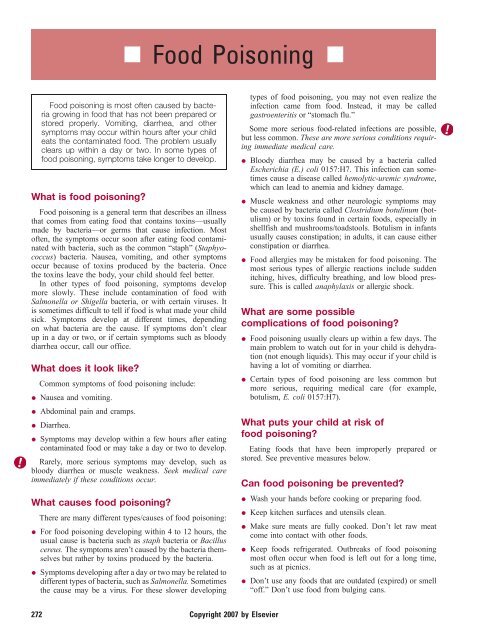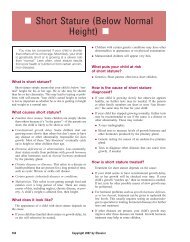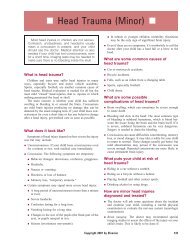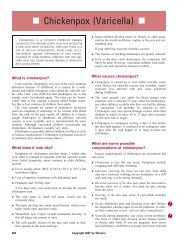Food Poisoning - Impcna.com
Food Poisoning - Impcna.com
Food Poisoning - Impcna.com
You also want an ePaper? Increase the reach of your titles
YUMPU automatically turns print PDFs into web optimized ePapers that Google loves.
n <strong>Food</strong> <strong>Poisoning</strong> n<br />
!<br />
<strong>Food</strong> poisoning is most often caused by bacteria<br />
growing in food that has not been prepared or<br />
stored properly. Vomiting, diarrhea, and other<br />
symptoms may occur within hours after your child<br />
eats the contaminated food. The problem usually<br />
clears up within a day or two. In some types of<br />
food poisoning, symptoms take longer to develop.<br />
What is food poisoning?<br />
<strong>Food</strong> poisoning is a general term that describes an illness<br />
that <strong>com</strong>es from eating food that contains toxins—usually<br />
made by bacteria—or germs that cause infection. Most<br />
often, the symptoms occur soon after eating food contaminated<br />
with bacteria, such as the <strong>com</strong>mon “staph” (Staphyococcus)<br />
bacteria. Nausea, vomiting, and other symptoms<br />
occur because of toxins produced by the bacteria. Once<br />
the toxins leave the body, your child should feel better.<br />
In other types of food poisoning, symptoms develop<br />
more slowly. These include contamination of food with<br />
Salmonella or Shigella bacteria, or with certain viruses. It<br />
is sometimes difficult to tell if food is what made your child<br />
sick. Symptoms develop at different times, depending<br />
on what bacteria are the cause. If symptoms don’t clear<br />
up in a day or two, or if certain symptoms such as bloody<br />
diarrhea occur, call our office.<br />
What does it look like?<br />
Common symptoms of food poisoning include:<br />
Nausea and vomiting.<br />
Abdominal pain and cramps.<br />
Diarrhea.<br />
Symptoms may develop within a few hours after eating<br />
contaminated food or may take a day or two to develop.<br />
Rarely, more serious symptoms may develop, such as<br />
bloody diarrhea or muscle weakness. Seek medical care<br />
immediately if these conditions occur.<br />
types of food poisoning, you may not even realize the<br />
infection came from food. Instead, it may be called<br />
gastroenteritis or “stomach flu.”<br />
Some more serious food-related infections are possible,<br />
but less <strong>com</strong>mon. These are more serious conditions requiring<br />
immediate medical care.<br />
Bloody diarrhea may be caused by a bacteria called<br />
Escherichia (E.) coli 0157:H7. This infection can sometimes<br />
cause a disease called hemolytic-uremic syndrome,<br />
which can lead to anemia and kidney damage.<br />
Muscle weakness and other neurologic symptoms may<br />
be caused by bacteria called Clostridium botulinum (botulism)<br />
or by toxins found in certain foods, especially in<br />
shellfish and mushrooms/toadstools. Botulism in infants<br />
usually causes constipation; in adults, it can cause either<br />
constipation or diarrhea.<br />
<strong>Food</strong> allergies may be mistaken for food poisoning. The<br />
most serious types of allergic reactions include sudden<br />
itching, hives, difficulty breathing, and low blood pressure.<br />
This is called anaphylaxis or allergic shock.<br />
What are some possible<br />
<strong>com</strong>plications of food poisoning?<br />
<strong>Food</strong> poisoning usually clears up within a few days. The<br />
main problem to watch out for in your child is dehydration<br />
(not enough liquids). This may occur if your child is<br />
having a lot of vomiting or diarrhea.<br />
Certain types of food poisoning are less <strong>com</strong>mon but<br />
more serious, requiring medical care (for example,<br />
botulism, E. coli 0157:H7).<br />
What puts your child at risk of<br />
food poisoning?<br />
Eating foods that have been improperly prepared or<br />
stored. See preventive measures below.<br />
Can food poisoning be prevented?<br />
Wash your hands before cooking or preparing food.<br />
Keep kitchen surfaces and utensils clean.<br />
Make sure meats are fully cooked. Don’t let raw meat<br />
<strong>com</strong>e into contact with other foods.<br />
Keep foods refrigerated. Outbreaks of food poisoning<br />
most often occur when food is left out for a long time,<br />
such as at picnics.<br />
Don’t use any foods that are outdated (expired) or smell<br />
“off.” Don’t use food from bulging cans.<br />
!<br />
What causes food poisoning?<br />
There are many different types/causes of food poisoning:<br />
For food poisoning developing within 4 to 12 hours, the<br />
usual cause is bacteria such as staph bacteria or Bacillus<br />
cereus. The symptoms aren’t caused by the bacteria themselves<br />
but rather by toxins produced by the bacteria.<br />
Symptoms developing after a day or two may be related to<br />
different types of bacteria, such as Salmonella. Sometimes<br />
the cause may be a virus. For these slower developing<br />
272<br />
Copyright 2007 by Elsevier
<strong>Food</strong> <strong>Poisoning</strong> n 273<br />
!<br />
How is food poisoning treated?<br />
For the most <strong>com</strong>mon types of food poisoning, no treatment<br />
is needed. Vomiting, diarrhea, and other symptoms<br />
get better in a few days.<br />
Antibiotic treatment may or may not be needed, even if<br />
the cause is bacteria. Symptoms are usually caused by<br />
toxins produced by the bacteria. Once the toxins are<br />
gone, your child should feel better.<br />
If the doctor does re<strong>com</strong>mend antibiotics, make sure<br />
your child finishes his or her prescription; don’t stop<br />
giving the medication because he or she seems better.<br />
The doctor may re<strong>com</strong>mend tests to determine what is<br />
causing your child’s vomiting, diarrhea, or other symptoms.<br />
On the other hand, if your child has typical symptoms<br />
that are clearly related to eating contaminated food,<br />
no testing may be needed.<br />
Regardless of the cause of nausea and vomiting, the most<br />
important treatment is fluid replacement to prevent dehydration.<br />
This is especially true in infants, who can lose<br />
body fluids very rapidly.<br />
Special solutions, such as Pedialyte, are available to<br />
replace lost body fluids. These products provide not only<br />
water but also necessary sugars and electrolytes (salts).<br />
If your child be<strong>com</strong>es dehydrated, he or she may need<br />
larger amounts of these fluids. The fluids can be given<br />
in small amounts frequently: as little as a teaspoon every<br />
minute or two. Over time, you can gradually give larger<br />
amounts of fluid replacement less often. Your child can<br />
eat other foods too, if tolerated.<br />
Giving fluids is important, even if your child is vomiting.<br />
Vomiting usually decreases with time.<br />
If vomiting continues or is severe, and your child is not<br />
“holding down” any fluids, he or she may need to go to<br />
the hospital. There he or she can receive intravenous (IV)<br />
fluid replacement, along with other needed treatment.<br />
Usually, children shouldn’t use over-the-counter antidiarrheal<br />
medicines, such as Imodium or Kaopectate. These<br />
products don’t help much and may cause side effects.<br />
If your child has any of the more serious food-related<br />
infections, other treatments will be re<strong>com</strong>mended. If your<br />
child hasn’t recovered in the expected time or if new<br />
symptoms develop, call our office.<br />
When should I call your office?<br />
Call our office if:<br />
Your child’s vomiting, diarrhea, and other symptoms<br />
don’t clear up within 2 or 3 days.<br />
Your child has severe or continued vomiting that makes<br />
it difficult to give enough fluids.<br />
If any of the following appear, call our office immediately:<br />
Diarrhea with visible blood.<br />
Muscle weakness or other neurologic symptoms.<br />
Symptoms of dehydration:<br />
Dry mouth.<br />
Decreased tears.<br />
Weight loss.<br />
Little or no urine produced.<br />
Fast heartbeat.<br />
Irritability or extreme tiredness.<br />
In infants, going 6 to 8 hours without wetting a diaper;<br />
sunken eyes or soft spot at the top of the head<br />
(fontanelle)<br />
!<br />
Copyright 2007 by Elsevier













